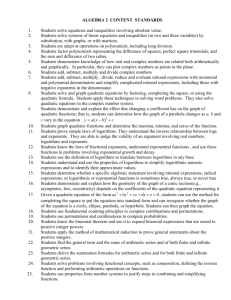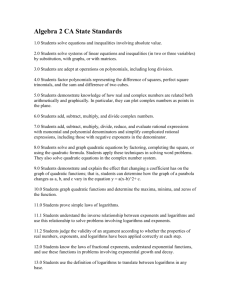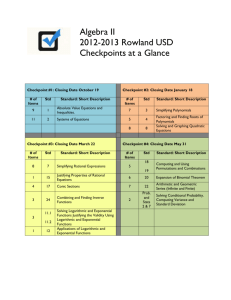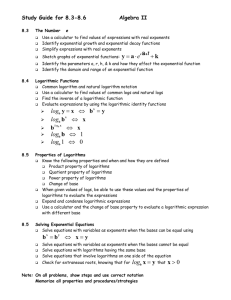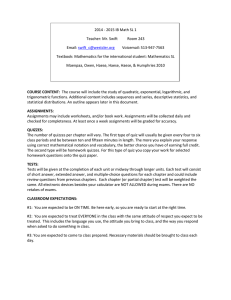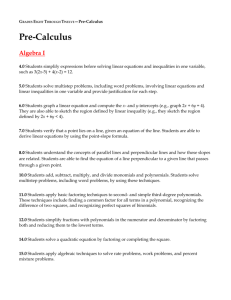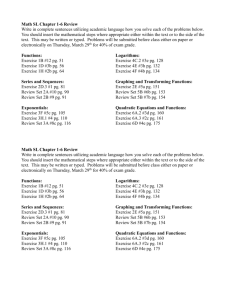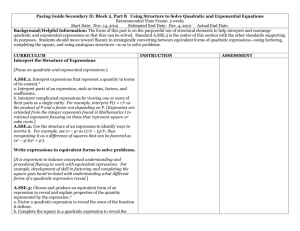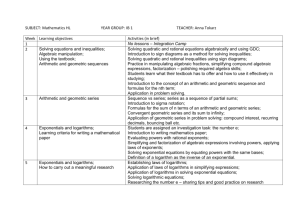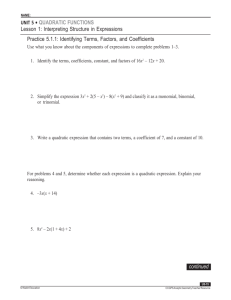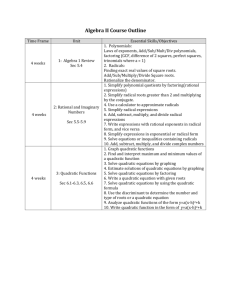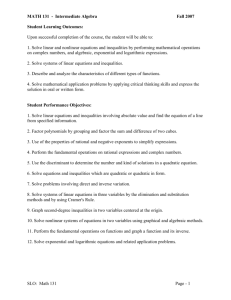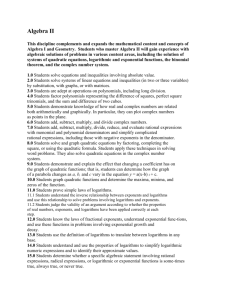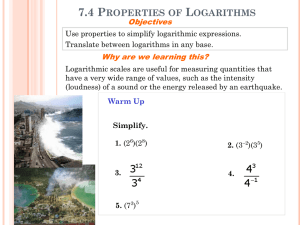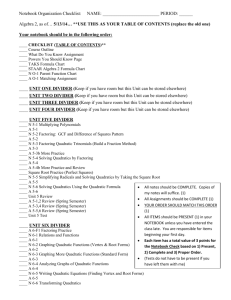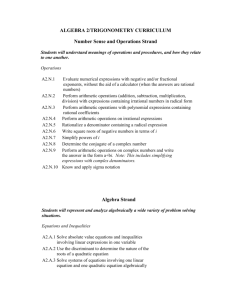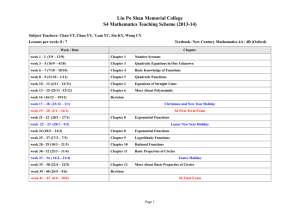algebra 2
advertisement
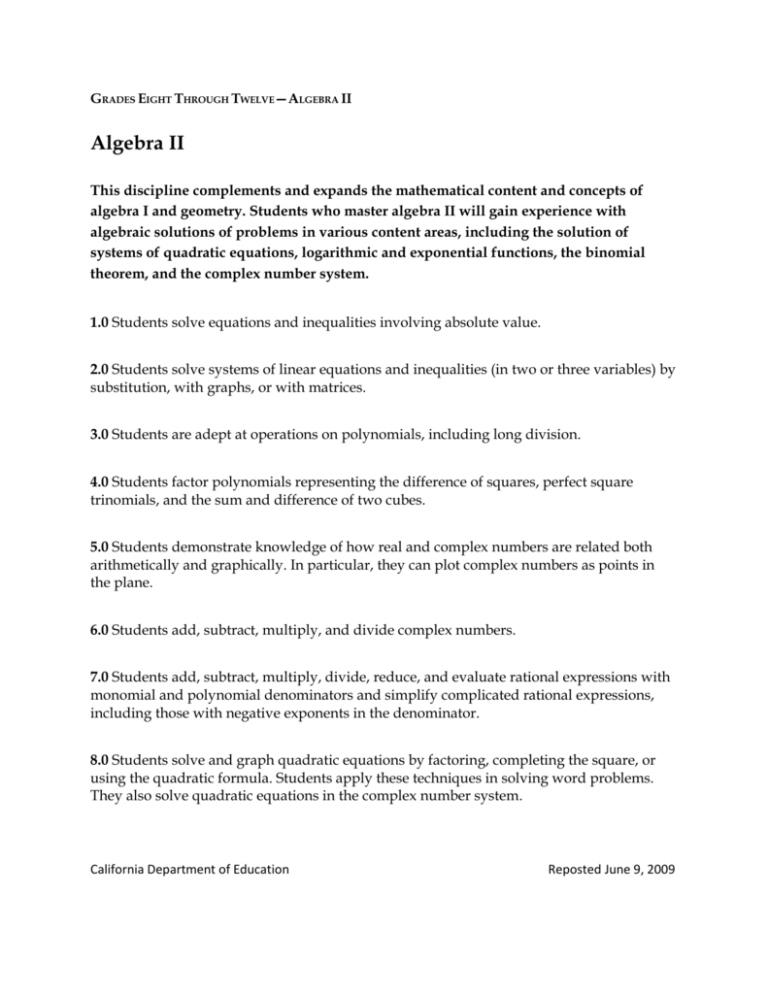
GRADES EIGHT THROUGH TWELVE—ALGEBRA II Algebra II This discipline complements and expands the mathematical content and concepts of algebra I and geometry. Students who master algebra II will gain experience with algebraic solutions of problems in various content areas, including the solution of systems of quadratic equations, logarithmic and exponential functions, the binomial theorem, and the complex number system. 1.0 Students solve equations and inequalities involving absolute value. 2.0 Students solve systems of linear equations and inequalities (in two or three variables) by substitution, with graphs, or with matrices. 3.0 Students are adept at operations on polynomials, including long division. 4.0 Students factor polynomials representing the difference of squares, perfect square trinomials, and the sum and difference of two cubes. 5.0 Students demonstrate knowledge of how real and complex numbers are related both arithmetically and graphically. In particular, they can plot complex numbers as points in the plane. 6.0 Students add, subtract, multiply, and divide complex numbers. 7.0 Students add, subtract, multiply, divide, reduce, and evaluate rational expressions with monomial and polynomial denominators and simplify complicated rational expressions, including those with negative exponents in the denominator. 8.0 Students solve and graph quadratic equations by factoring, completing the square, or using the quadratic formula. Students apply these techniques in solving word problems. They also solve quadratic equations in the complex number system. California Department of Education Reposted June 9, 2009 9.0 Students demonstrate and explain the effect that changing a coefficient has on the graph of quadratic functions; that is, students can determine how the graph of a parabola changes 2 as a, b, and c vary in the equation y = a(x-b) + c. 10.0 Students graph quadratic functions and determine the maxima, minima, and zeros of the function. 11.0 Students prove simple laws of logarithms. 11.1 Students understand the inverse relationship between exponents and logarithms and use this relationship to solve problems involving logarithms and exponents. 11.2 Students judge the validity of an argument according to whether the properties of real numbers, exponents, and logarithms have been applied correctly at each step. 12.0 Students know the laws of fractional exponents, understand exponential functions, and use these functions in problems involving exponential growth and decay. 13.0 Students use the definition of logarithms to translate between logarithms in any base. 14.0 Students understand and use the properties of logarithms to simplify logarithmic numeric expressions and to identify their approximate values. 15.0 Students determine whether a specific algebraic statement involving rational expressions, radical expressions, or logarithmic or exponential functions is sometimes true, always true, or never true. 16.0 Students demonstrate and explain how the geometry of the graph of a conic section (e.g., asymptotes, foci, eccentricity) depends on the coefficients of the quadratic equation representing it. 17.0 Given a quadratic equation of the form ax + by + cx + dy + e = 0, students can use the method for completing the square to put the equation into standard form and can recognize whether the graph of the equation is a circle, ellipse, parabola, or hyperbola. Students can then graph the equation. 2 2 18.0 Students use fundamental counting principles to compute combinations and permutations. California Department of Education Reposted June 9, 2009 19.0 Students use combinations and permutations to compute probabilities. 20.0 Students know the binomial theorem and use it to expand binomial expressions that are raised to positive integer powers. 21.0 Students apply the method of mathematical induction to prove general statements about the positive integers. 22.0 Students find the general term and the sums of arithmetic series and of both finite and infinite geometric series. 23.0 Students derive the summation formulas for arithmetic series and for both finite and infinite geometric series. 24.0 Students solve problems involving functional concepts, such as composition, defining the inverse function and performing arithmetic operations on functions. 25.0 Students use properties from number systems to justify steps in combining and simplifying functions. California Department of Education Reposted June 9, 2009
